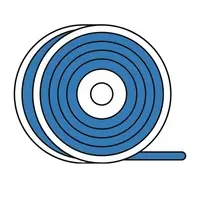HIPS Filament Print Settings & Material Information
HIPS print settings (Cura profile import, how it is done ...)
 Download Cura profile for our
Download Cura profile for our  HIPS filament.
HIPS filament.
 Here you will find the matching
Here you will find the matching  HIPS filaments.
HIPS filaments.
 Data sheet for our
Data sheet for our  HIPS filament.
HIPS filament.
HIPS material summary
HIPS (High-Impact Polystyrene) is a thermoplastic polystyrene which has optimum properties in terms of hygiene, strength and heat resistance.
HIPS is mainly used by industry in the food and packaging sector. HIPS is a stable material - in terms of impact resistance and stiffness it is comparable with ABS. The load capacity exceeds PLA. In addition, the filament has a low water absorption.
Fine details and smooth surfaces can be printed optimally, as well as problem-free post-processing such as painting, spraying with acrylic paints and sanding are possible with HIPS. Individual parts can be bonded with most commercially available adhesives. Polystyrene dissolves completely in limonene extract (e.g. D-Limonene). Limonene does not react with ABS, therefore HIPS is suitable support material for ABS.
HIPS advantages
HIPS disadvantages
HIPS print area (recommendations)
Since each 3D printer has its own parameter preferences, adjustments to the settings and fine-tuning are necessary to achieve optimal print results.
** depending on the printing bed adhesion method also slightly less (e.g. with BlueTape possibly 10 to 30°C less)
Spool dimensions
Compability:
Our filaments are suitable for all common 3D printers (FDM / FFF - Fused Deposition Modeling / Fused Filament Fabrication).
Nevertheless, the instructions of the printer manufacturer regarding nozzle diameter, filament material, filament diameter and coil dimensions should be observed.
Storage:
Due to the hygroscopic property (ability to bind water) of some materials, we recommend all filaments indoors to store at room temperature and of course dry. Air-tight ZIP bags or containers with the desiccant SILICA are well suited for this.
The filaments should not hang on the printer for a long time, but always be airtight when not in use and stored with sufficient SILICA sealed.
It is also recommended to dry the filament (especially NYLON and PVA materials) before use (see section "Drying")
Desiccation (drying):
Due to the temperature differences on the transport route or through the storage itself, air may have sneaked into the packaging film. Often, the material may have absorbed some moisture between the manufacturing process and sealing (NYLON and PVA are extremely hygroscopic).
Therefore, we recommend drying overnight in a dehydrator (vegetable dryer) or a few hours in a convection oven (filament and coil only, without foil).
SPECIALTY with transparent colors!
Low humidity has no or hardly any effect on "colored" filaments, only with transparent filaments, some moisture can already lead to cloudiness.
A table with common drying times and temperatures per material is attached. A lump-sum duration for the drying is not to call. Because it depends on how much moisture the filament has already pulled.
A test pressure before drying should serve as the starting point.
The drying time should be tested with about 100g of filament, which has previously separated from the coil. So we say 3x 100g filament in the oven, the first takes after 30 min, the second after 60 min and the third after 120 min out. Afterwards you make another test print with each part. The experiences made can then be transferred to the entire coil. Or if you are not in a hurry, the filament roll in a dehydrator (vegetable dryer) for a few days should also lead to the desired success.
ABS at 50°C to 80°C approx. 4h* with circulating air
PETG at 50°C to 80°C approx. 4h* with circulating air
NYLON at 60°C to 80°C approx. 8h* with circulating air
PVA at 60°C to 80°C approx. 8h* with circulating air
* Drying time varies depending on the degree of moisture in the filament and environmental influences.
It should also be noted whether the coil will withstand the temperature you have chosen.
 HIPS filament.
HIPS filament. HIPS filaments.
HIPS filaments.  HIPS filament.
HIPS filament.
HIPS (High-Impact Polystyrene) is a thermoplastic polystyrene which has optimum properties in terms of hygiene, strength and heat resistance.
HIPS is mainly used by industry in the food and packaging sector. HIPS is a stable material - in terms of impact resistance and stiffness it is comparable with ABS. The load capacity exceeds PLA. In addition, the filament has a low water absorption.
Fine details and smooth surfaces can be printed optimally, as well as problem-free post-processing such as painting, spraying with acrylic paints and sanding are possible with HIPS. Individual parts can be bonded with most commercially available adhesives. Polystyrene dissolves completely in limonene extract (e.g. D-Limonene). Limonene does not react with ABS, therefore HIPS is suitable support material for ABS.
HIPS advantages
- more flexible and tougher than PLA
- ideal support material
- hardly any warping
- problem-free bonding and post-processing
- low moisture absorption
- heat resistant
- resistant to alkalis
- completely soluble in limonene extract (e.g. D-Limonene)
HIPS disadvantages
- no UV-resistance
- heating bed and possibly adhesion enhancer necessary for better adhesion
HIPS print area (recommendations)
| Print temperature: | 190°C | to | 240°C |
| Print bed temperature:** | 80°C | to | 110°C |
| Print speed: | 40mm/s | to | 110mm/s |
| Travel speed: | 80mm/s | to | 140mm/s |
Since each 3D printer has its own parameter preferences, adjustments to the settings and fine-tuning are necessary to achieve optimal print results.
** depending on the printing bed adhesion method also slightly less (e.g. with BlueTape possibly 10 to 30°C less)
Spool dimensions
| Z3D 3D-Drucker-Filament.de |
1kg (net) | 0,5kg (net) |
| Outer Ø: | 200mm | 200mm |
| Inne hole: | 53mm | 53mm |
| Thickness: | 65mm | 38mm |
| eSun | 1kg (net) | 0,5kg (net) |
| Outer Ø: | 200mm | 200mm |
| Inner hole: | 52mm | 52mm |
| Thickness: | 70mm | 42mm |
General information about our filaments
Compability:
Our filaments are suitable for all common 3D printers (FDM / FFF - Fused Deposition Modeling / Fused Filament Fabrication).
Nevertheless, the instructions of the printer manufacturer regarding nozzle diameter, filament material, filament diameter and coil dimensions should be observed.
Storage:
Due to the hygroscopic property (ability to bind water) of some materials, we recommend all filaments indoors to store at room temperature and of course dry. Air-tight ZIP bags or containers with the desiccant SILICA are well suited for this.
The filaments should not hang on the printer for a long time, but always be airtight when not in use and stored with sufficient SILICA sealed.
It is also recommended to dry the filament (especially NYLON and PVA materials) before use (see section "Drying")
Desiccation (drying):
Due to the temperature differences on the transport route or through the storage itself, air may have sneaked into the packaging film. Often, the material may have absorbed some moisture between the manufacturing process and sealing (NYLON and PVA are extremely hygroscopic).
Therefore, we recommend drying overnight in a dehydrator (vegetable dryer) or a few hours in a convection oven (filament and coil only, without foil).
SPECIALTY with transparent colors!
Low humidity has no or hardly any effect on "colored" filaments, only with transparent filaments, some moisture can already lead to cloudiness.
A table with common drying times and temperatures per material is attached. A lump-sum duration for the drying is not to call. Because it depends on how much moisture the filament has already pulled.
A test pressure before drying should serve as the starting point.
The drying time should be tested with about 100g of filament, which has previously separated from the coil. So we say 3x 100g filament in the oven, the first takes after 30 min, the second after 60 min and the third after 120 min out. Afterwards you make another test print with each part. The experiences made can then be transferred to the entire coil. Or if you are not in a hurry, the filament roll in a dehydrator (vegetable dryer) for a few days should also lead to the desired success.
Drying times (recommendations):
PLA at 40°C to 50°C approx. 4h* with circulating airABS at 50°C to 80°C approx. 4h* with circulating air
PETG at 50°C to 80°C approx. 4h* with circulating air
NYLON at 60°C to 80°C approx. 8h* with circulating air
PVA at 60°C to 80°C approx. 8h* with circulating air
* Drying time varies depending on the degree of moisture in the filament and environmental influences.
It should also be noted whether the coil will withstand the temperature you have chosen.
